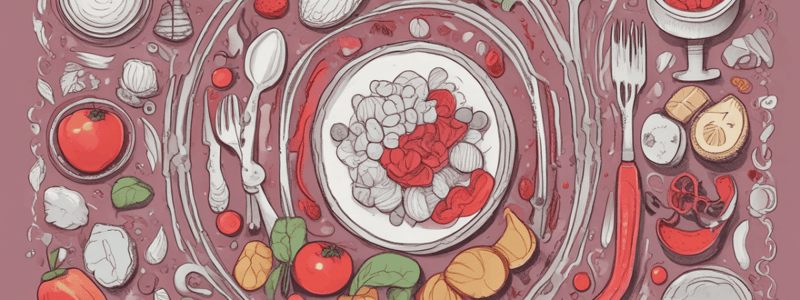Podcast
Questions and Answers
Which of the following statements about iron deficiency is CORRECT?
Which of the following statements about iron deficiency is CORRECT?
- The body readily absorbs iron from the diet, making iron deficiency a less common issue.
- Iron deficiency is a rare condition, affecting less than 50 million people worldwide.
- Iron deficiency is primarily caused by a lack of dietary iron, making it more common in high-income populations.
- Iron deficiency is mainly observed in populations where iron absorption is compromised due to factors like parasitic infections and poor diet. (correct)
What are the two primary red cell indices that are reduced in iron deficiency anemia, leading to microcytic and hypochromic red blood cells?
What are the two primary red cell indices that are reduced in iron deficiency anemia, leading to microcytic and hypochromic red blood cells?
- Hematocrit (Hct) and Platelet Count (PLT)
- Mean Corpuscular Volume (MCV) and Mean Corpuscular Hemoglobin (MCH) (correct)
- Red Blood Cell Count (RBC) and Hemoglobin (Hb)
- White Blood Cell Count (WBC) and Mean Platelet Volume (MPV)
Which protein is primarily responsible for transporting iron to tissues, including erythroblasts in the bone marrow?
Which protein is primarily responsible for transporting iron to tissues, including erythroblasts in the bone marrow?
- Hemoglobin
- Transferrin Receptor 1 (TfR1)
- Ferritin
- Transferrin (correct)
What is the main source of iron released into plasma transferrin, after red blood cells reach their lifespan?
What is the main source of iron released into plasma transferrin, after red blood cells reach their lifespan?
What is the main difference between iron deficiency anemia and anemia of chronic disease?
What is the main difference between iron deficiency anemia and anemia of chronic disease?
Which of the following is NOT a characteristic of iron deficiency anemia?
Which of the following is NOT a characteristic of iron deficiency anemia?
Which of the following statements about iron transport is CORRECT?
Which of the following statements about iron transport is CORRECT?
What is the primary function of caeruloplasmin in relation to iron metabolism?
What is the primary function of caeruloplasmin in relation to iron metabolism?
Which protein undergoes a reduction in synthesis during iron overload?
Which protein undergoes a reduction in synthesis during iron overload?
How does iron deficiency affect the binding of iron regulatory protein (IRP) to iron response elements (IREs)?
How does iron deficiency affect the binding of iron regulatory protein (IRP) to iron response elements (IREs)?
Which complex is primarily responsible for the storage of iron within macrophages?
Which complex is primarily responsible for the storage of iron within macrophages?
What happens to the levels of ferritin and ALA-S during iron deficiency?
What happens to the levels of ferritin and ALA-S during iron deficiency?
Which of the following is a characteristic of haemosiderin compared to ferritin?
Which of the following is a characteristic of haemosiderin compared to ferritin?
What is the consequence of iron overload in relation to parenchymal cells?
What is the consequence of iron overload in relation to parenchymal cells?
How are the levels of protein synthesis for iron metabolism linked to body iron status?
How are the levels of protein synthesis for iron metabolism linked to body iron status?
Flashcards are hidden until you start studying
Study Notes
Iron Deficiency and Anaemia
- Iron is abundant in the Earth’s crust but its deficiency is the leading cause of anaemia, affecting around 500 million globally.
- High prevalence in low-income regions, notably sub-Saharan Africa and South Asia, where poor dietary quality and parasitic infections exacerbate iron loss.
- Anaemia due to iron deficiency presents as microcytic, hypochromic, characterized by low mean corpuscular volume (MCV) and mean corpuscular haemoglobin (MCH), resulting in small, pale red blood cells.
- Main differential diagnoses for microcytic, hypochromic anaemia include iron deficiency, anaemia of chronic disease, and thalassaemia.
Iron Transport and Storage
- Iron transport and storage are facilitated by three key proteins: transferrin, transferrin receptor 1 (TfR1), and ferritin.
- Each transferrin molecule can bind up to two iron atoms, delivering iron primarily to erythroblasts in the bone marrow for haemoglobin synthesis.
- After red blood cells age, they are degraded in macrophages, releasing iron back into plasma, which associates with transferrin.
- Dietary iron absorption occurs predominantly in the duodenum and jejunum, constituting a minor portion of plasma transferrin iron.
- Excess iron beyond haemoglobin synthesis is also recycled into transferrin from erythrocytes.
- Ferritin, a water-soluble protein containing 20% iron by weight, acts as a store for iron and is not visible through light microscopy.
- Haemosiderin is an insoluble iron complex, containing around 37% iron, visible after staining; it arises from the partial digestion of ferritin.
Iron Regulation Mechanisms
- Synthesis levels of ferritin, TfR1, δ-aminolaevulinic acid synthase (ALA-S), and divalent metal transporter 1 (DMT-1) closely relate to iron status.
- Iron overload causes ferritin levels to rise while decreasing TfR1 and DMT-1, whereas iron deficiency leads to low ferritin and ALA-S and increased TfR1.
- Iron regulatory proteins (IRPs) bind to iron response elements (IREs) on mRNAs for ferritin, TfR1, ALA-S, and DMT-1, regulating protein synthesis based on iron levels.
- Upstream binding of IRP to IREs decreases protein synthesis, while downstream binding stabilizes mRNA, enhancing translation.
- Elevated plasma iron levels lead to increased iron transfer to organs, causing tissue damage and pathological conditions associated with iron overload.
- Free iron in plasma (non-transferrin bound iron) poses a toxicity risk to various organs.
Studying That Suits You
Use AI to generate personalized quizzes and flashcards to suit your learning preferences.




